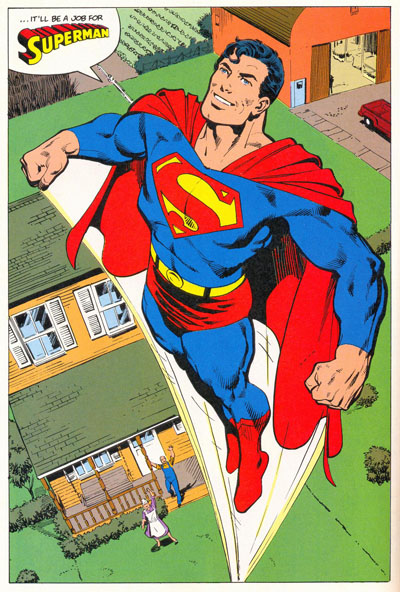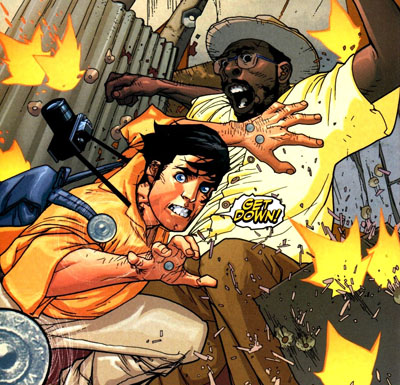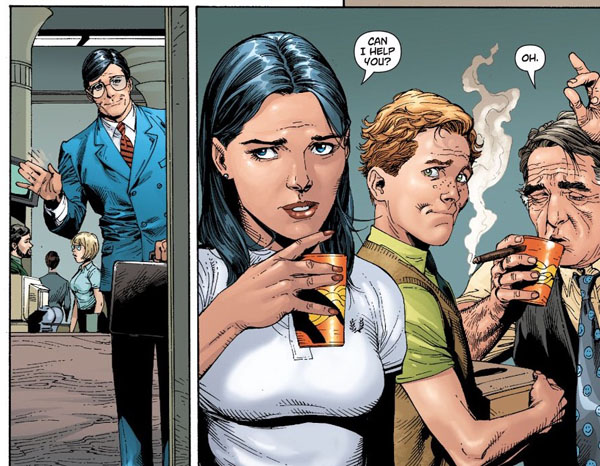
The Many Origins of Superman!
It’s incredible that, eighty years after his creation by writer Jerry Siegel and artist Joe Shuster, Superman remains such a popular character, one who is known and loved worldwide. Even if you’ve never read a single comic book in your entire life, I bet you know who Superman is! It’s quite extraordinary.
Something that has always intrigued me about DC Comics is their willingness to continually recreate their superhero universe, tossing out the old and restarting their characters from scratch. This can make their continuity difficult to follow at times, as past stories are continually rewritten and/or shunted aside, and yet I suspect it has also helped to keep these characters relevant and viable.
Recently, I’ve found myself rereading several retellings of Superman’s origin. It’s been fascinating to compare and contrast these different versions of the classic origin story that we all think we know!

At the time, the six-issue-long Man of Steel felt like a very leisurely-paced retelling of Superman’s origin. Re-reading the series today, though, it feels a little quaint at how fast things go. Clark Kent is adult Superman, in full costume, by the end of issue #1! That’s a LOT of story compressed into that one issue! (The TV show Smallville took TEN seasons to get to that same end point!)
At the time, Mr. Byrne made some bold changes to pre-established Superman comic book lore with the series. He established a cold, sterile depiction of Krypton. He brought both Kent parents back to life (rather than having Pa Kent die young, as was so powerfully depicted in the first Donner Superman movie as well as earlier comic books). He presented a modern characterization of Lois Lane as smart, tough, and independent. He presented a modern characterization of Lex Luthor as a rich, powerful businessman who was the most powerful man in Metropolis before Superman’s arrival on the scene. So many of these aspects of the story, large and small, are indelibly fixed in my mind as the “correct” version of Superman’s origin and world.
I enjoy Mr. Byrne’s thoughtfulness in thinking through so many of the accepted aspects of Superman’s story. Mr. Byrne attempts to give us explanations as to why Krypton exploded, why Superman has superhuman powers on Earth, why Kryptonite can harm Kryptonians, why Superman’s super-suit doesn’t usually get torn up in combat, etc. (I was particularly intrigued by Mr. Byrne’s portrayal of how the radiation plaguing Krypton before its destruction created, as a side-effect of the damage that would lead to the planet’s destruction, this new radioactive material that killed many Kryptonians before the planet exploded. It’s a great expansion of the familiar Superman lore and a great answer to the old question of why a rock from Superman’s home planet would be deadly to him.)
I’d forgotten that Byrne’s Lex Luthor had hair! He had male pattern baldness, so that bald dome was still an aspect of Mr. Byrne’s depiction of Lex, but still, it was fun to see Lex with hair! (This was part of Byrne’s reworking of Lex as a more realistic human adversary to Supes, rather than his being a cartoonish super-villain. Byrne’s Lex looks like a normal guy!) I enjoyed the time Mr. Byrne devoted in issue #3 to Superman’s first meeting with Batman.
Mr. Byrne is a comic book master, and I love this artwork from the prime of his career. His Superman remains definitive to me. His Lois is a bit dated sometimes in terms of the way she is dressed, but it works OK (and did certainly feel very modern and of the moment in 1986!), and I do love how Mr. Byrne made Lois beautiful and sexy, as well as being intelligent and tough as nails. I love Mr. Byrne’s sci-fi depiction of Krypton in the opening pages of issue #1. From the idyllic Kent family farmhouse to the skyscrapers of Metropolis, Mr. Byrne’s illustrations are fantastic throughout this series..
There are aspects of the storytelling that feel dated, almost thirty years later. The story is very fast-paced, and some of the dialogue is very declarative and a little cliche “comic-booky.” But still, Man of Steel holds up as a terrific version of Superman’s origin.

There’s a lot to enjoy in Birthright! It doesn’t feel nearly as definitive as Man of Steel or Secret Origins (which I’ll discuss in a moment!) to me, though. There are many aspects of this version of Superman’s origin which don’t seem to have stuck or appeared again outside of this one story. (As an example, this series suggests that Superman’s “S” shield was the flag of Krypton. That’s an interesting idea! In the afterward to the collected edition, Mark Waid argues passionately for why that would make more sense than the “S” being the symbol of the House of El as seen in the Donner Superman movies — because Superman would stand for unity rather than tribalism — but that idea doesn’t seem to have caught on beyond this story.) But still, taken on its own, this is a very enjoyable and creative depiction of Superman’s early days!
I particularly loved the early chapters which depicted Clark Kent in Africa, struggling to find out how best to use both his skills as a reporter as well as his superpowers in order to affect positive change. First off, it’s great seeing black people in a Superman comic (as Supes’ main cast of heroes and villains remains to this day very white), and I loved this version of Clark, driven and noble but struggling to figure out what he is meant to be doing and how best he can help people. Generally, Superman origin stories have Clark going directly from Smallville to Metropolis. But this shows us a Batman Begins style middle-era, in which Clark is a young man searching to find himself and his purpose. I loved that.
As was the case in Smallville, this story suggests that Clark and Lex were friends as kids in Smallville, before having a falling out. (As for why that hasn’t been acknowledged by other Superman comic book stories of the time, Birthright suggests that Lex is embarrassed by his time in Smallville and has sought to destroy all record of his time there, and refuses to acknowledge that he knows Clark when they meet again as adults. That’s an intriguing idea that fits with Lex Luthor’s psychology.)
I used to love Leinil Yu’s artwork, though in recent years I have sometimes found his work to look rushed and scratchy. But his artwork here, beautifully inked by Gerry Alanguilan, is gorgeous. Mr. Yu’s unique approach to panel-design (in which he often uses crazy angles and unusual perspective) and character (his distinct way of drawing faces has always seemed to me to be influenced by the look of the great Kevin Nowlan’s work) truly shines in Birthright. Mr. Alanguilan’s crisp, clear ink lines bring this work to life.

As someone who grew up loving Richard Donner’s Superman films (flaws and all), it was always somewhat weird to me how different the iconography of those films was from anything I saw in the comic books. But Secret Origin borrows heavily from those films, seamlessly integrating those ideas with much of Superman’s familiar comic book history. I love seeing the crystalline look for the Fortress of Solitude (as well as other Kryptonian technology) from the films depicted here! I love that Lois can’t spell, and that Clark is always bumbling and knocking things over, just like in the films. Most impressively, I absolutely love the way Gary Frank has drawn his Clark Kent/Superman to resemble Christopher Reeve. It’s really quite extraordinary! While still giving Superman the bulk and power that he has on the comic book page (and that Mr. Reeve did not have in those movies, as great as he was on-screen), and without resorting to caricature, Mr. Frank has been able to make his Clark/Superman look just like Christopher Reeve! It works SO GREAT on these pages, and it tugs on my nostalgic heart-strings in a surprisingly powerful way.
As was the case on Smallville and in Birthright, here in Secret Origin we see that Lex and Clark knew one another as kids in Smallville. Secret Origin takes more time than either of Birthright or Man of Steel to explore Clark’s life as a kid in Smallville, what it was like for him to discover his powers and his alien nature. I love those first two issues that focus on that period in young Clark’s life! This is my favorite part of the story! I love seeing his relationship with his parents at this stage, and with young Lana Lang. (I wish we saw more of Lana after the second issue. She’s a great character, and I’d love to see more of where her story went.) (Poor Lana, a character for whom I have always had a fondness, seems to get the short shrift in most of these stories. In Birthright, there’s a comment that she vanished from Smallville soon after Clark Left, which feels like the set-up for a mystery but is never referenced again! I will say that I was intrigued by the melancholy twist John Byrne gave to Lana’s story when he brought her back in the final issue of Man of Steel. I didn’t love that plot twist, but I did love that Mr. Byrne hadn’t forgotten about Lana and was attempting to give the character her due and also to show us what happened to her as she grew up.) Getting back to Secret Origin and those great first two issues: Geoff John’s story is quite emotional, as he puts us in young Clark’s shoes, and shows us his struggles and his loneliness, and also his inherent goodness.
Secret Origin has an emotional depth that makes it feel grounded, while also embracing many of the more fantastical elements of Superman’s comic book history. Issue #2 introduces the Legion of Superheroes and tells a story of young Clark’s journey into the far future!! (And we also eventually get to super villains Metallo and the Parasite.) But it all works, and these story elements all fit together beautifully.
I feel like Mr. Johns and Mr. Frank got all of the characters absolutely right. Let’s start with Clark. Many depictions of Superman struggle with how to depict Clark Kent. Though I fondly referenced the bumbling Christopher Reeve movie version of Clark Kent a few paragraphs ago, I actually think the movies were over-the-top in Clark’s goofiness. The Richard Donner movies get too silly for me with how they depict Clark. John Byrne’s Man of Steel, recognizing that Clark Kent would have the same muscular build as Superman, presented him as a high School football star (not the wimp getting teased by the football players as seen in Superman: The Movie). Secret Origin finds a sweet spot in the middle. We see that Clark does purposefully act bumbling in order to distract people and differentiate himself from Superman, but he’s also more normal and real, and we see that as Clark he still has many positive qualities that allow him to be successful at work at the Daily Planet and to make friends.
Lois, meanwhile, is depicted as talented and driven, a superstar reporter, without crossing over the line into recklessness or arrogance. Jimmy is young and endearing without being to cartoonishly goofy or naive. Perry is tough but driven to publish the truth. The Lex Luthor we meet here is the almost-all-powerfiul businessman like the Lex from Man of Steel, though we also get aspects of Lex’s older comic book history as a super genius inventor. (Lex here is completely bald, unlike the Lex from Man of Steel!) Whereas the Lex in Man of Steel isn’t immediately threatened by Superman, and only turns against him after Supes spurns his offer to work for him and winds up getting Lex briefly arrested, here in Secret Origin we see the version of Lex that has been more often used in recent years, in which Lex is immediately jealous and disdainful of the alien superhero. As with all the characters in Secret Origin, this Lex feels like a perfect distillation of many previous depictions of the character, while keeping him realistically human and relatable/modern. It’s a very clever balancing act that Mr. Johns and Mr. Frank have pulled off.
All of these characters are a perfect combination of Mr. John’s great writing and Mr. Frank and inker Jon Sibal’s gloriously beautiful artwork. I swear, there are panels in these comics that I could stare at for hours. I wish that these six issues were just the beginning of an epic fifty-issues-plus run of Superman stories by this creative team!
Sadly, it’s not. This mini-series came at the end of Mr. Johns & Mr. Frank’s all-to-brief run on Superman. If Secret Origin has a weakness, it’s that in many ways it’s as stand-alone as Birthright was. Neither seemed to connect too strongly to the main Superman comic books of their era.
The “New 52” — Back in 2011, DC Comics again rebooted their entire universe, ending all of their comic-book series and re-launching 52 titles with new #1 issues, in what they called “The New 52.” Grant Morrison took over as the writer for Action Comics, and created yet another new version of Superman and his origin. Mr. Morrison presented us with a young, inexperienced version of Superman, one who had just recently arrived in Metropolis. This Superman was crafted, intentionally, to more closely resemble Superman as he was when he was originally created back in the ’30s. While Mr. Morrison’s run has already been ignored/re-written by DC, and is so weird that it definitely doesn’t feel to me like a definitive new version of Superman, I will say that when judged on it’s own, I think Mr. Morrison’s twisty, complicated story is pretty great and a lot of fun! I wrote at length about Mr. Morrison’s interesting run on Superman here.
It was a lot of fun to read these different versions of Superman’s origin! It’s fascinating to see how elastic this character and his famous origin story can be. I enjoyed all three of these different versions. They’re each interesting in their own right. Man of Steel is the one I feel most comfortable with, as that’s the version I grew up with. But as a stand-alone story, I enjoyed Secret Origin the best. (It really does break my heart that we don’t see more of Secret Origin’s version of Superman and his cast of supporting characters!!)
What’s your favorite version of the origin of Superman…?
The stories I discussed in this review can be purchased here: Man of Steel, Superman: Birthright, and Superman: Secret Origin. Happy reading!

